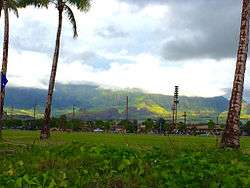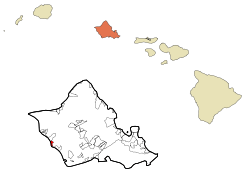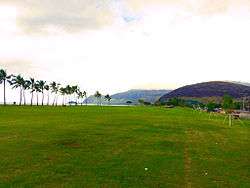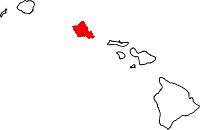Māili, Hawaii
Māʻili is a census-designated place (CDP) in the Waiʻanae District on the island of Oʻahu, City & County of Honolulu, Hawaiʻi, United States. In Hawaiian, māʻili means "pebbly", referring to rounded stones at the shore.[1][2][3][4] Māʻili is located along Farrington Highway on Oʻahu’s Leeward Coast, between Māʻili Beach Park to the west and Lualualei Valley to the east. It is located 1.4 miles south of the town of Waianae, separated by the Māʻiliʻili Stream, and 1.5 miles north of Nanakuli.[5] As of the 2010 Census, the town population was 9,488.[6] Māʻili has one 7-Eleven, a gas station, and a few residential developments.[7] The town is also home to several dairy farms and vegetable plots. Two tall, red antennae near the mouth of the Lualualei Valley are parts of the Navcom Radio Transmitting Facility,[8] and were the tallest man-made structures in the Western Hemisphere at 1,503 feet when they were built in 1972.[9] The town has an elevation of twenty feet.[5]
Māʻili | |
|---|---|
 Māʻili with the Lualualei Valley and the Waianae Range in the background. | |
 Location in Honolulu County and the state of Hawaii | |
| Coordinates: 21°25′6″N 158°10′43″W | |
| Country | United States |
| State | Hawaii |
| Area | |
| • Total | 2.8 sq mi (7.3 km2) |
| • Land | 1.7 sq mi (4.4 km2) |
| • Water | 1.1 sq mi (2.8 km2) |
| Elevation | 13 ft (4 m) |
| Population (2010) | |
| • Total | 9,488 |
| • Density | 3,400/sq mi (1,300/km2) |
| Time zone | UTC-10 (Hawaii-Aleutian) |
| Area code(s) | 808 |
| FIPS code | 15-47300 |
| GNIS feature ID | 0361999 |
Māʻili has among the highest percentage of Native Hawaiians in Hawai’i, with 48.8% of the population in 2009.[10] Māʻili and its waterfront park, Māʻili Beach Park, is a popular destination for surfing, snorkeling, swimming, boogieboarding, and bodyboarding.[7] Māʻili Beach Park has a total area of forty acres,[11] and is located immediately south of Lualualei Beach Park.[12] The park is home to two popular Hawaiian surf spots: Green Lanterns by the mouth of the Māʻiliʻili Stream, and Tumbleland in the center of the beach park.[2][4][11] The water conditions are treacherous during winter-time, but usually calm during summer. The beach park has a lifeguard station, a playground, beach facilities, restrooms, picnic tables, and showers.[2][12]
Geography

Māʻili is located at 21°25′6″N 158°10′43″W (21.418333, -158.178736).[13] According to the United States Census Bureau, the CDP has a total area of 2.8 square miles (7.3 km2), of which 1.7 square miles (4.4 km2) is land and 1.1 square miles (2.8 km2), or 38.92%, is water.[14] It is located on the Waimea Coast of Oʻahu, between the ocean-front Māʻili Beach Park and the Lualualei Valley at the foot of the Waianae Range. It is located 1.4 miles south of the town of Waianae, separated by the Māʻiliʻili Stream, and 1.5 miles north of Nanakuli.
Demographics
As of the census[15] of 2000, there were 5,943 people, 1,359 households, and 1,178 families residing in the CDP. The population density was 6,241.5 people per square mile (2,415.4/km2). There were 1,502 housing units at an average density of 1,577.5 per square mile (610.4/km2). The racial makeup of the CDP was 11.07% White, 0.91% African American, 0.24% Native American, 22.56% Asian, 23.89% Pacific Islander, 1.09% from other races, and 40.23% from two or more races. Hispanic or Latino of any race were 14.67% of the population.
There were 1,359 households, out of which 42.3% had children under the age of 18 living with them, 58.9% were married couples living together, 19.8% had a female householder with no husband present, and 13.3% were non-families. 9.5% of all households were made up of individuals, and 3.8% had someone living alone who was 65 years of age or older. The average household size was 4.22 and the average family size was 4.35.
In the CDP the population was spread out, with 35.0% under the age of 18, 10.4% from 18 to 24, 27.2% from 25 to 44, 18.4% from 45 to 64, and 9.0% who were 65 years of age or older. The median age was 28 years. For every 100 females there were 103.0 males. For every 100 females age 18 and over, there were 98.3 males.
The median income for a household in the CDP was $45,786, and the median income for a family was $48,068. Males had a median income of $33,229 versus $21,211 for females. The per capita income for the CDP was $13,185. About 19.3% of families and 21.5% of the population were below the poverty line, including 28.3% of those under age 18 and 9.1% of those age 65 or over.
Education
The Hawaii Department of Education operates the public schools. Maili Elementary School is located in the CDP.[16]
References
- Dame, Frederick William (2013). The Muslim Discovery of America. BoD – Books on Demand. Page 205. ISBN 9783848238637.
- Lucier, Jessica Lane and Evelyn Z. Hsieh (2008). Let's Go Hawaii (5th Edition). Macmillan. Page 185. ISBN 9780312385798.
- Fodor, Eugene (1974). Fodor's Hawaii. D. McKay Co. Page 198. ISBN 9780679009276.
- http://oceansafety.ancl.hawaii.edu/v/2.0/?i=oahu&shid=2&bch=maili
- http://www.city-data.com/city/Maili-Hawaii.html
- "Profile of General Population and Housing Characteristics: 2010 Demographic Profile Data (DP-1): Maili CDP, Hawaii". United States Census Bureau. Retrieved May 22, 2012.
- Demello, Julie (2009). Fun with the Family Hawaii: Hundreds Of Ideas For Day Trips With The Kids. Rowman & Littlefield. Page 35. ISBN 9781461747406.
- Pager, Sean and Sheryl Groden Pager (2006). Off the Beaten Path Hawaii. Globe Pequot. Page 129. ISBN 9780762742004.
- http://www.to-hawaii.com/oahu/beaches/mailibeachpark.php
- Nagengast, Colin (2009). Almanac of American Demographics. Colin Nagengast. Page 584. ISBN 9781438991061.
- Clark, John R.K. (2005). Beaches of O’ahu. University of Hawaii Press. Page 150. ISBN 9780824828929.
- Bendure, Glenda (1995). Hawaii: A Lonely Planet Travel Survival Kit. Lonely Planet. Page 221. ISBN 9780864422620.
- "US Gazetteer files: 2010, 2000, and 1990". United States Census Bureau. 2011-02-12. Retrieved 2011-04-23.
- "Geographic Identifiers: 2010 Demographic Profile Data (G001): Maili CDP, Hawaii". United States Census Bureau. Retrieved May 22, 2012.
- "U.S. Census website". United States Census Bureau. Retrieved 2008-01-31.
- "Maili CDP, Hawaii." U.S. Census Bureau. Retrieved on May 21, 2009.
